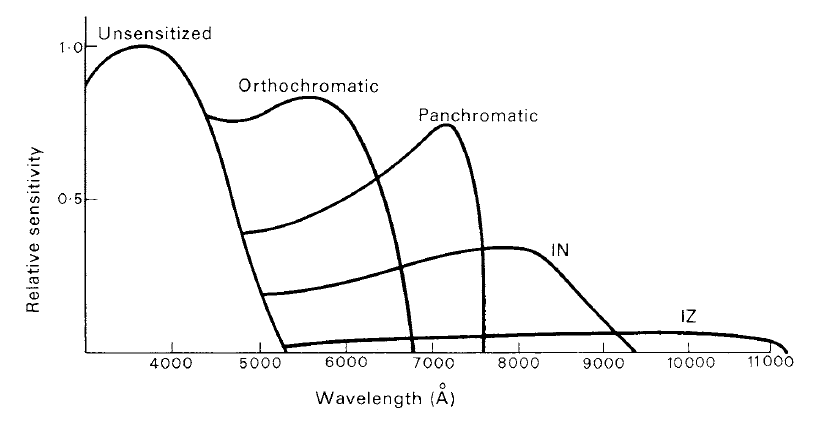
The photographic plate: Speed
 المؤلف:
A. Roy, D. Clarke
المؤلف:
A. Roy, D. Clarke
 المصدر:
Astronomy - Principles and Practice 4th ed
المصدر:
Astronomy - Principles and Practice 4th ed
 الجزء والصفحة:
p 286
الجزء والصفحة:
p 286
 23-8-2020
23-8-2020
 1856
1856
The photographic plate: Speed
The time of exposure required to obtain an image of a certain strength of a particular astronomical object with a given telescope varies according to the emulsion type that is used. A plate or film is said to have a certain speed, designating the amount of energy that needs to fall on to the emulsion to produce a good image.

Figure 1. Relative spectral sensitivity of typical unsensitized, orthochromatic, panchromatic and infrared (IN and IZ) emulsions.
Obviously, it is important that any observation should be recorded in the shortest possible time by choosing a plate with a fast emulsion. However, the choice of speed has to be considered in relation to criteria which may be set by other requirements of the measurement.
It is usually the case that as the speeds of emulsion increase, so does the graininess—it is impossible to have a film with a high resolving power and fast speed. If, therefore, a particular measurement requires an emulsion with a high resolving power, then any notion of making the observation with a short exposure time may need to be sacrificed. Practically all astronomical photography is performed by using long exposures. During the exposure, the whole ‘picture-area’ is receiving the general scattered light from the sky background and from the optical system at the same time as the image of importance is being recorded. Thus, any image is recorded against a background which is generally termed the fog. Any image can only be seen well when its strength is significantly above the fog-level. The ability of plates to have low fog-levels varies according to the type of emulsion but it is usually the case that fast emulsions are susceptible to fog. If a particular measurement requires a faint object to be recorded, it would be thought that this could be done most quickly by using the fastest film. If, however, the object is to be recorded with maximum contrast against the fog, it may not necessarily follow that the fastest emulsion is the correct choice. A slower emulsion and longer exposure time may produce a better result.
 الاكثر قراءة في مواضيع عامة في علم الفلك
الاكثر قراءة في مواضيع عامة في علم الفلك
 اخر الاخبار
اخر الاخبار
اخبار العتبة العباسية المقدسة


